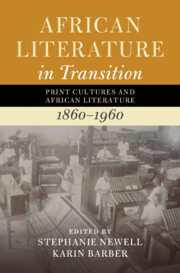Refine search
Actions for selected content:
1186 results
16 - Gum Tears Which Are Also Real
-
-
- Book:
- The Cambridge History of Australian Poetry
- Published online:
- 19 November 2025
- Print publication:
- 11 December 2025, pp 295-312
-
- Chapter
- Export citation
7 - Settler Labour Poetics and the National Imaginary at the Turn of the Twentieth Century
-
-
- Book:
- The Cambridge History of Australian Poetry
- Published online:
- 19 November 2025
- Print publication:
- 11 December 2025, pp 137-149
-
- Chapter
- Export citation
8 - Children’s Poetry from 1840 to 1950
-
-
- Book:
- The Cambridge History of Australian Poetry
- Published online:
- 19 November 2025
- Print publication:
- 11 December 2025, pp 150-168
-
- Chapter
- Export citation

Afro-Mexican Lives in the Long Nineteenth Century
- Slavery, Freedom, and the Writing of History
-
- Published online:
- 20 November 2025
- Print publication:
- 04 December 2025
15 - The Crimea Annexation and the Russia–Ukraine War
- from Part IV - The Nuclear Era
-
- Book:
- Crises, War, and Diplomacy
- Published online:
- 07 November 2025
- Print publication:
- 20 November 2025, pp 336-366
-
- Chapter
- Export citation
17 - Transformation and Reversion, 1989–1999
-
- Book:
- Distant Friends and Intimate Enemies
- Published online:
- 30 October 2025
- Print publication:
- 20 November 2025, pp 371-392
-
- Chapter
- Export citation
Chapter 15 - “The World Is Up for Grabs”
- from Part III - Contemporary Reconfigurations or Shifting Globalities and Positionalities
-
-
- Book:
- African Literature in Transition
- Published online:
- 07 November 2025
- Print publication:
- 20 November 2025, pp 270-290
-
- Chapter
- Export citation
4 - The Italian War of Independence 1859–1860
- from Part II - The Post-Napoleonic Nineteenth Century
-
- Book:
- Crises, War, and Diplomacy
- Published online:
- 07 November 2025
- Print publication:
- 20 November 2025, pp 61-84
-
- Chapter
- Export citation
3 - Racial Citizenship Moments
- from Part I - Ghana–Soviet Entanglements
-
- Book:
- Socialist De-Colony
- Published online:
- 10 November 2025
- Print publication:
- 20 November 2025, pp 118-162
-
- Chapter
-
- You have access
- Open access
- HTML
- Export citation
Chapter 1 - Unfinished Communities
- from Part I - Decolonization Currents
-
-
- Book:
- African Literature in Transition
- Published online:
- 07 November 2025
- Print publication:
- 20 November 2025, pp 23-47
-
- Chapter
- Export citation
Chapter 15 - Orthographic Arguments
- from Part III - New Genres
-
-
- Book:
- African Literature in Transition
- Published online:
- 23 October 2025
- Print publication:
- 06 November 2025, pp 294-312
-
- Chapter
- Export citation
3 - The Costs of Success: The Democrat Party in Power, 1950–1954
-
- Book:
- The Rise and Fall of Turkey's Democrat Party
- Published online:
- 23 October 2025
- Print publication:
- 06 November 2025, pp 99-143
-
- Chapter
- Export citation
Chapter 8 - ‘How to cultivate a love for reading’
- from Part II - Readers and Audiences
-
-
- Book:
- African Literature in Transition
- Published online:
- 23 October 2025
- Print publication:
- 06 November 2025, pp 166-183
-
- Chapter
- Export citation
“Blackshirts” and “Blacklists”: The Politics of Late-Colonial Central Kenya, 1958–1963
-
- Journal:
- Itinerario , First View
- Published online by Cambridge University Press:
- 27 October 2025, pp. 1-16
-
- Article
-
- You have access
- Open access
- HTML
- Export citation

African Literature in Transition
- Print Cultures and African Literature, 1860–1960
-
- Published online:
- 23 October 2025
- Print publication:
- 06 November 2025
3 - Reception and Legacy of Farrenc’s Nonet
-
- Book:
- Louise Farrenc: Nonet for Winds and Strings
- Published online:
- 23 October 2025
- Print publication:
- 23 October 2025, pp 118-142
-
- Chapter
- Export citation
Ambiguous Echoes of the Colonial Partition: Alternative Futures from the Casamançais Past in Senegal
-
- Journal:
- The Journal of African History / Volume 66 / 2025
- Published online by Cambridge University Press:
- 17 October 2025, e22
-
- Article
-
- You have access
- Open access
- HTML
- Export citation
9 - Bohemian Public Music Institutions and National Politics
- from Part II - The “Long” Nineteenth Century
-
-
- Book:
- A History of Music in the Czech Lands
- Published online:
- 21 October 2025
- Print publication:
- 16 October 2025, pp 131-143
-
- Chapter
- Export citation
3 - Postwar Minority Politics
-
- Book:
- Minority Identities in Nigeria
- Published online:
- 26 September 2025
- Print publication:
- 16 October 2025, pp 96-134
-
- Chapter
- Export citation
14 - Choral Music and Modernity in the Bohemian Crownlands in the Nineteenth Century
- from Part II - The “Long” Nineteenth Century
-
-
- Book:
- A History of Music in the Czech Lands
- Published online:
- 21 October 2025
- Print publication:
- 16 October 2025, pp 199-211
-
- Chapter
- Export citation
